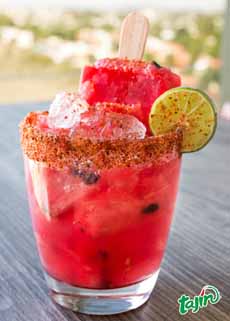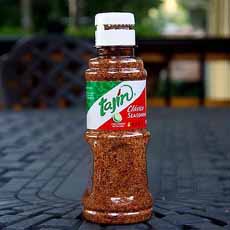TIP OF THE DAY: Sweet & Spicy Flavor Pairings For Foods & Drinks
 [1] Watermelon agua fresca with a spicy rim of Tajín seasoning. Or, switch out the salt on your Margarita. Here’s the recipe (photos #1, #2 and #3 © Tajín Seasoning).
|
Mankind has been combining sweet and spicy flavors since ancient times…and up to just yesterday (2016), when Doritos Spicy Sweet Chili tortilla chips appeared on store shelves. The combination of sweet heat has been part of global cuisines from Asia to Mexico. If you’ve never sprinkled a mango or lime paleta—a Mexican ice pop—with spicy heat, you’ve been missing out! Cultures around the world variously use black pepper, chiles, horseradish, mustard, wasabi, and white pepper for heat. Whatever the combination with whatever sweet element (agave, honey, sugar, fruit), after an initial bite of sweet, the heat builds into a kick: a combination that appeals to many. For Cinco de Mayo, we’re focusing on the famous heat of Latin America: hot chiles (all about chiles). At the restaurant level, the sweet-and-spicy combination has been showcased in casual fare (burgers, chicken wings, pizza), chocolate (bars, bonbons, desserts, and spicy hot chocolate). Ketchup and other sweet condiments are good candidates to combine sweetness and heat. Small manufacturers have long been featuring sweet and spicy, from jerky flavors to rice chips, tortilla chips, and crackers. Even chocolate bars, a standard-bearer for sweet, have been combined with spicy for at least 20 years. Today, you’ll find this combination in everything from savory Mexican mole sauce to desserts. In fact, the first chocolate consumed—an Aztec beverage for the elite—ground roasting cacao beans, with and vanilla—plus chiles, allspice and spicy petals from a local tree (Cymbopetalum penduliflorum, a member of the custard apple family known in English as sacred earflower. While honey only arrived with the Conquistadors in 1519, the local agave sap was not used as a sweetener. Be sure to check out the sensory characteristics of spices, at the end of the article. Some of our favorites: More and more Americans are enjoying spicier foods, due to the growth in popularity of International cuisines (not just Mexican, but Indian, Thai and numerous others). They ported the sweet-heat combinations found in ethnic dishes to provide a more complex depth of flavor to traditional, European-based foods. Mexican hot chocolate, anyone? If you’re ready for some sweet heat, start with a spice mix. You can play with hot sauce and sliced or pureed jalapeños later. Mix your own hot spice blend (more about that below), or buy a bottle of Tajín seasoning. Made by Tajín Products, a Mexican company, this mildly spicy seasoning combines chili, lime and salt. It is delicious on fruits: citrus, cucumber, melon, and tropical fruit (mango, papaya, pineapple, etc.); and in cooked fruit recipes. It’s a versatile seasoning. In addition to its popularity as a glass rimmer for cocktails or juice drinks, try it on: If you want to make your own, mix lime zest with cayenne, chile flakes, chile powder, jalapeño—or go beyond Mexico to layer on international heat: black pepper (India), horseradish (Mediterranean), hot paprika (Spanish Basque region), mustard powder (China) or wasabi (Japan). You can add yet another layer your spice mix—perhaps some cumin or curry powder. |
|
|
THE SENSORY CHARACTERISTICS OF SPICES What Are Spices? Spices don’t have a single flavor profile: They have several. Thanks to Spices Inc. for this analysis of the 15 most commonly used sensory characteristics when describing the flavor and aroma profiles of spices. Both spices and herbs are obtained from plants. CHECK OUT WHAT’S HAPPENING ON OUR HOME PAGE, THENIBBLE.COM.
|
||







